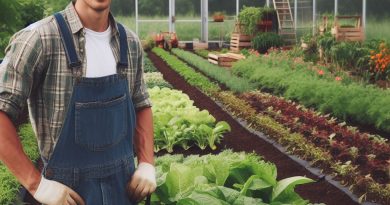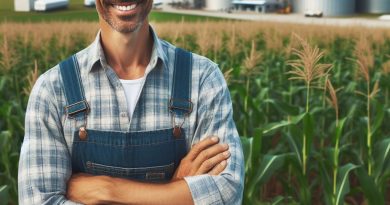Water Wisdom: Conserving H2O in Eco-Farms
Last Updated on January 19, 2024
Introduction
Water conservation is crucial in eco-farms for sustainable farming practices.
This blog post provides an overview of effective strategies for conserving water in eco-farms.
We will explore various methods to conserve water in eco-farms and promote sustainability.
In the intricate tapestry of sustainable agriculture, where every thread is woven with a commitment to environmental harmony, one pivotal element emerges as the lifeblood of ecological farms—water.
As custodians of our planet’s well-being, eco-farmers embark on a journey guided by the profound philosophy of “Water Wisdom,” recognizing the indispensable role that judicious water conservation plays in nurturing both the soil and the soul of their endeavors.
This exploration delves into the nuanced art of preserving H2O within the realm of eco-farming, unraveling the intricate strategies, innovative practices, and the overarching ethos that propels a sustainable, water-conscious agricultural paradigm.
Join us in this voyage where the essence of water meets the wisdom of eco-farming, forging a path towards a greener, more resilient future for our planet.
Understanding water usage in eco-farms
Explaining the water requirements for various eco-farm activities
- Organic farming practices such as crop rotation and cover cropping require adequate water to support plant growth.
- Livestock farming in eco-farms needs water for drinking, cleaning, and maintaining animal health.
- Aquaculture systems in eco-farms rely heavily on water for fish or shellfish cultivation.
- Greenhouses and nurseries require water for seed germination, plant propagation, and maintaining optimal growing conditions.
- Irrigation systems in eco-farms play a crucial role in delivering water to plants efficiently.
Highlighting the significance of water for crop irrigation
- Crop irrigation accounts for the majority of water usage in eco-farms.
- Water is essential for crops to germinate, grow, and produce high-quality yields.
- Adequate irrigation helps prevent crop stress, disease, and nutrient deficiencies.
- Water availability directly affects plant health, productivity, and overall farm profitability.
- Efficient irrigation methods, such as drip irrigation, reduce water waste and ensure optimal water use.
Discussing the challenges in managing water resources in eco-farms
- Limited water resources pose a significant challenge for eco-farms in meeting their water demands.
- Climate change impacts water availability, with unpredictable rainfall patterns and droughts becoming more frequent.
- Balancing water requirements between different activities within eco-farms can be complex.
- Proper water management strategies, such as rainwater harvesting and water recycling, are crucial for sustainable farming.
- Collaborative efforts between eco-farms, researchers, and policymakers are necessary to address water management challenges.
In short, understanding water usage in eco-farms is vital for effective conservation and sustainable farming practices.
Eco-farm activities, such as organic farming, livestock farming, aquaculture, and greenhouse cultivation, all depend on adequate water supply.
Crop irrigation, in particular, plays a significant role in plant growth and overall farm productivity.
However, managing water resources in eco-farms presents challenges due to limited availability and the impacts of climate change.
Implementing water-efficient practices and collaborative approaches are essential for ensuring the long-term viability of eco-farming.
Read: Soil Health: The Heart of Organic Farming
Efficient irrigation techniques
Introduction to drip irrigation systems
Drip irrigation is a water-saving technique that involves delivering small, frequent, and precise amounts of water directly to plant roots.
It uses a network of pipes, tubing, and emitters to distribute water slowly and efficiently.
Drip irrigation systems can be used in various types of eco-farms, including urban gardens, vineyards, and large-scale agricultural operations.
This method ensures that water is applied only where it is needed, reducing water wastage and maximizing plant growth.
Drip irrigation systems work by delivering water at a slow rate, allowing it to penetrate the soil fully and minimize runoff.
They can be customized to suit different crops and soil conditions, ensuring optimal water distribution and plant health.
Additionally, drip irrigation systems can be automated, reducing the need for manual labor and providing consistent watering.
Benefits of drip irrigation in conserving water
Drip irrigation offers numerous benefits when it comes to conserving water resources.
Firstly, it significantly reduces water wastage by delivering water directly to the plant’s root zone, minimizing evaporation and runoff.
Compared to traditional sprinkler systems, which can lose up to 50% of water through evaporation and wind drift, drip irrigation is highly efficient.
Secondly, drip irrigation systems promote water conservation by allowing farmers to control the precise amount of water each plant receives.
This ensures that plants are neither overwatered nor underwatered, resulting in healthier crops and optimized water usage.
Drip irrigation also helps to prevent weed growth, as water is only provided to the target plants, minimizing competition for resources.
Furthermore, by providing water directly to the root zone, drip irrigation reduces the moisture on leaves and stems, preventing disease and fungal issues.
In eco-farms, where sustainability is a priority, drip irrigation plays a crucial role in responsible water management.
Discussion on other efficient irrigation methods (e.g., sprinklers, micro-sprinklers)
While drip irrigation is a popular choice for eco-farms, it is not the only efficient irrigation technique available.
Sprinklers, for example, are commonly used in larger agricultural operations.
They use overhead sprinklers to distribute water in a circular pattern, covering a large area.
Sprinklers are useful for crops that require uniform watering or for cooling purposes.
However, they can be less water-efficient than drip irrigation, as water is exposed to evaporation and wind drift.
Micro-sprinklers, on the other hand, combine the advantages of both drip irrigation and sprinklers.
They deliver water in a fine mist or spray, targeting specific plants or areas.
Micro-sprinklers are effective for gently watering delicate crops or providing localized moisture in dry regions.
They can also help with cooling effects and frost protection.
In fact, efficient irrigation techniques are vital for conserving water in eco-farms.
Drip irrigation, with its precise water delivery and customizable design, is a particularly effective method.
However, sprinklers and micro-sprinklers also have their place in certain farming scenarios.
Ultimately, the choice of irrigation system should be based on the specific needs of the crops, soil, and environmental conditions on the eco-farm.
Read: Organic Fertilizers: Nature’s Crop Boosters
Crop selection and water management
Importance of selecting appropriate crops for eco-farms
Choosing the right crops is crucial for water conservation on eco-farms.
- Start by assessing the climate and water availability of the region.
- Opt for crops that require minimal water and can thrive in your specific conditions.
- Native plants are often well-adapted to local climates and can be excellent choices.
- Consider drought-tolerant crops like barley, millet, sorghum, and certain types of legumes.
- These crops have evolved to survive in water-limited environments and can significantly reduce water usage.
Highlighting drought-resistant crop varieties
Certain crop varieties are naturally resistant to drought and can be a game-changer for eco-farms.
- Research and identify crop varieties that have high drought resistance.
- These varieties are bred to withstand prolonged dry periods and still produce decent yields.
- Drought-resistant varieties often have deeper root systems that explore more soil space for water.
- Examples include heirloom tomatoes, drought-tolerant corn, and climate-adapted beans.
- By selecting such varieties, farmers can ensure a more sustainable use of water resources.
Exploring crop rotation and companion planting techniques for water conservation
Crop rotation and companion planting techniques can contribute to efficient water management on eco-farms.
- Crop rotation helps mitigate disease and pest problems, reducing the need for excessive watering.
- By rotating crops, farmers can break pest cycles and maintain healthier soil, reducing water demands.
- Growing legumes, such as beans or clover, in rotation can also improve soil fertility and water retention.
- Companion planting involves strategically pairing crops that benefit each other.
- For instance, planting crops with different root depths can optimize water usage and reduce competition.
In essence, crop selection and water management are vital components of water conservation on eco-farms.
By choosing appropriate crops, utilizing drought-resistant varieties, and implementing crop rotation and companion planting techniques, farmers can significantly reduce water usage and ensure long-term sustainability.
It is crucial for eco-farms to actively adopt these practices to mitigate the impact of water scarcity and contribute to a more resilient agricultural system.
Read: Eco-Farm Basics: Sustainable Agriculture 101
Mulching and soil moisture retention
Explanation of mulching and its benefits for water retention
Mulching is the process of covering the soil with a layer of organic or synthetic materials.
It has several benefits for water retention in eco-farms.
Firstly, it acts as a barrier, preventing water evaporation from the soil surface. This helps to conserve water and maintain soil moisture levels.
Secondly, mulch helps to regulate soil temperature, preventing extreme heat or cold that can affect water availability.
Lastly, it reduces soil erosion, which further aids in water conservation.
Discussing different types of mulch (e.g., organic, plastic) and their effectiveness
There are various types of mulch that can be used in eco-farms to retain soil moisture.
Organic mulch, such as straw, wood chips, or leaves, is often preferred as it decomposes over time, adding nutrients to the soil.
This type of mulch is effective in retaining moisture and improving soil structure.
On the other hand, plastic mulch, made of materials like polyethylene, is non-biodegradable but highly effective in conserving water.
It forms a barrier against evaporation and helps to warm the soil, particularly in cooler climates.
Techniques for applying mulch to retain soil moisture in eco-farms
Proper application of mulch is essential for efficient water retention in eco-farms. Here are some techniques:
- Prepare the soil: Clear any weeds, grass, or debris before applying mulch to ensure direct contact with the soil.
- Choose the right mulch: Consider the specific needs of the crop and the climate when selecting the type of mulch to use.
- Apply the mulch layer: Spread a layer of mulch around 2-4 inches thick on the soil surface, leaving space around the plant stems.
- Maintain mulch thickness: Regularly check the mulch layer’s thickness and add more as needed to maintain its effectiveness.
- Water properly: Mulch should be watered thoroughly, ensuring the moisture reaches the soil beneath.
- Monitor for pests: Keep an eye out for pests that may hide or thrive in the mulch layer and take appropriate measures for control.
- Replace mulch when necessary: Organic mulch may require replacement as it decomposes over time, losing effectiveness in retaining moisture.
By implementing these techniques, eco-farms can maximize water conservation through effective mulching and soil moisture retention.
Read: Natural Pest Control: Organic Methods Unveiled

Rainwater Harvesting and Storage
Introduction to Rainwater Harvesting Systems
Rainwater harvesting systems collect and store rainwater from rooftops, driveways, and other surfaces for various uses.
Benefits of Rainwater Harvesting in Eco-Farms
- Water Conservation: Rainwater harvesting reduces dependence on traditional water sources, conserving precious freshwater resources.
- Irrigation: Collected rainwater can be used for irrigation, reducing the need for groundwater extraction and minimizing agricultural water stress.
- Organic Farming: Rainwater is free from chemicals, making it ideal for organic farming practices and improving crop quality.
- Cost Savings: Implementing rainwater harvesting systems can lead to significant cost savings on water bills for eco-farmers.
- Flood Mitigation: Harvesting rainwater reduces the risk of flooding by diverting excess water away from fields and structures.
- Drought Resilience: Stored rainwater can act as a buffer during dry spells, ensuring a continuous water supply for eco-farm operations.
- Environmental Impact: Rainwater harvesting reduces runoff, which can potentially carry pollutants into rivers, lakes, and groundwater sources.
Tips for Implementing Rainwater Harvesting and Storage Practices
- Assess Water Needs: Determine the water requirements of your eco-farm to determine the capacity needed for rainwater storage.
- Design Considerations: Plan the layout of gutters, downspouts, and storage tanks to optimize rainwater collection and minimize contamination risks.
- Select Appropriate Storage Tanks: Use high-quality, food-grade plastic or concrete tanks that are resistant to algae growth and are well-sealed.
- Filter System: Install a filter to remove debris and sediment from collected rainwater before it enters the storage tank.
- Maintenance: Regularly clean gutters, downspouts, and filters to ensure the system operates efficiently and to prevent blockages.
- Water Treatment: Consider implementing biodegradable and environmentally friendly treatments, such as chlorine-free options, for water purification.
- Overflow Prevention: Include an overflow outlet in the storage tank to prevent waterlogging and structural damage during heavy rainfall events.
- Utilize Water Efficiently: Implement water-efficient irrigation methods such as drip irrigation or timed sprinklers to maximize water use efficiency.
- Education and Training: Educate employees and farm workers on the benefits and proper use of rainwater harvesting systems.
- Monitoring and Evaluation: Regularly monitor water levels, system performance, and agricultural water use to identify areas for improvement.
In general, rainwater harvesting and storage systems offer numerous benefits to eco-farms, including water conservation, cost savings, and environmental sustainability.
By implementing these practices and following the suggested tips, eco-farmers can contribute to a more sustainable future for agriculture.
Monitoring and efficient water usage
Importance of regularly monitoring water usage in eco-farms
Regularly monitoring water usage in eco-farms is crucial to ensure efficient water management and conservation efforts.
It allows farmers to identify any water-related issues or inefficiencies promptly and take necessary actions.
By monitoring their water usage, eco-farmers can accurately assess their current water consumption and make informed decisions.
This practice helps in setting realistic targets for water conservation, which can be monitored and measured periodically.
It also provides the opportunity to quantify the results of water conservation efforts and track the progress over time.
Implementing water meters and sensors for effective water management
To achieve effective water management, eco-farms should consider implementing water meters and sensors.
Water meters provide accurate measurements of water consumption, enabling farmers to monitor their usage on a regular basis.
These meters can be installed at key points, such as irrigation systems or water storage tanks, to track water flow.
By monitoring water usage in real-time, farmers can identify any leaks or abnormalities and take immediate action.
Additionally, sensors can be used to measure soil moisture levels, allowing farmers to optimize irrigation practices.
These sensors provide data on the moisture content, helping eco-farmers make informed decisions regarding irrigation scheduling.
Techniques for reducing water wastage in eco-farm activities (e.g., washing, cleaning)
Eco-farm activities, such as washing and cleaning, should adopt techniques to minimize water wastage.
One effective method is to use low-flow or high-pressure nozzles for cleaning equipment and structures.
These nozzles reduce water consumption without compromising on the effectiveness of the cleaning process.
Implementing closed-loop systems for washing activities can also help in conserving water.
This system collects and recirculates water, minimizing the need for fresh water and reducing water wastage.
Moreover, eco-farmers can promote the use of efficient washing machines and appliances that consume less water.
By practicing good housekeeping techniques, such as fixing leaks and using water-efficient equipment, water wastage can be minimized in eco-farms.
Regular maintenance and inspection of water-related infrastructure are also essential to prevent any wastage due to malfunctioning equipment.
In a nutshell, monitoring water usage in eco-farms is vital for efficient water management and conservation efforts.
By implementing water meters and sensors, farmers can accurately track their water consumption.
Techniques to reduce water wastage in activities like washing and cleaning can further contribute to water conservation.
Efficient water usage in eco-farms plays a significant role in preserving this precious resource and ensuring a sustainable agricultural future.
Conclusion
Water conservation in eco-farms is of utmost importance for the sustainability of our planet.
Throughout this blog post, key strategies like drip irrigation, rainwater harvesting, and soil moisture monitoring have been discussed in detail.
I encourage all readers to implement these water-saving practices on their eco-farms for a more sustainable and environmentally-friendly approach to farming.
Let us all contribute to preserving our precious water resources for future generations.


